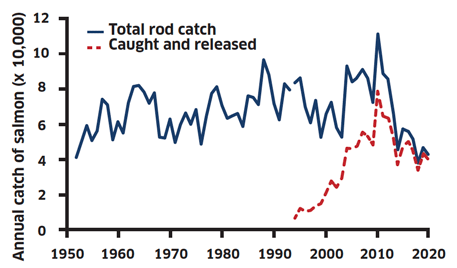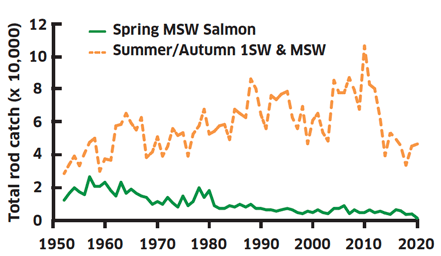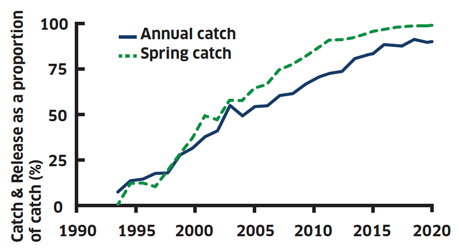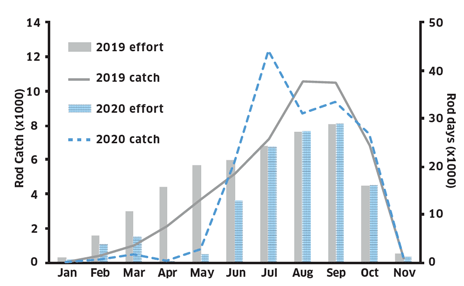Salmon fishery statistics: 2020
Summary of the salmon fishery catch statistics for the 2020 season.
Salmon fishery statistics - 2020 season
This publication summarises the salmon fishery statistics, based on returns from proprietors, occupiers or agents of fisheries throughout Scotland, for the 2020 fishing season. These data are derived from 1,961 forms returned from 2,155 forms issued (91% return rate). Catches for the previous 10 years are based on return rates of between 93% and 94%. These statistics are part of a time series which began in 1952 and are collected and collated by Marine Scotland Science.
Summary
- The total reported rod catch of wild salmon for 2020 is 45,366. This is the third lowest on record and 92% of the previous 5-year average, although the impact of the coronavirus pandemic complicates direct comparisons with previous years.
- Catch and release in 2020 accounted for 93% of the total rod catch and 99% of the rod caught spring multi sea-winter fish (taken before 1 May)
- Reported spring catches in 2020, which were affected by the coronavirus related national lockdowns, were 16% of the previous five year average. Prior to 2020 there was some indication that catches of spring fish had stabilised in recent years after a general decline since records began in 1952.
- In 2020 there was a slight increase in catches of summer multi sea-winter fish and a slight decrease in one sea-winter fish compared to 2019.
- Reported catch and effort for the net fisheries were among the lowest recorded since records began. There was no reported catch from fixed engine fisheries.
- Fish reported as being of farmed origin represented 1.3% of the total Scottish catch in 2020.
Salmon Fishery Regulations
Statutory conservation measures are in place to regulate both the killing of salmon in the early months of the fishing season, in coastal waters and on stocks with poor conservation status. These regulations will have an impact on the data reported by Scottish salmon fisheries.
Catch and Effort Reported by Scottish salmon Fisheries in 2020
The rod fishery
Of the 45,366 wild fish reported as caught in the rod fishery, 42,348 were subsequently released and 3,018 retained. Total rod catch of salmon has generally declined from its peak in 2010. The 2020 total rod catch was the third lowest on record and 92% of the previous five year average (Figure 1).

Trends in total rod catch vary among individual stock components (Figure 2). Catches of spring multi sea-winter (MSW) fish (taken before 1 May) have generally declined since records began and although stabilising in recent years, catches declined in 2020. Catch in later months (one sea-winter (1SW) and MSW caught after April) has generally declined since its peak in 2010, although in 2020 the summer/ autumn catch increased slightly.

Catch and release
The proportion of the rod catch accounted for by catch and release has generally increased since 1994, when such information was first recorded. In 2020, 93% of the annual rod catch, and 99% of the spring rod catch, were released (Figure 3). A proportion of fish released from the rod fishery may be re-caught and hence inflate the catch statistics by appearing in the reported data more than once.

The net fisheries
As a result of the Salmon Conservation Regulations, retention of salmon caught in coastal waters has been prohibited since the 2016 season. In 2020, a total of 780 wild fish were reported caught and retained in the net & coble fishery, the second lowest catch since 1952. The reported effort of 15.5 crew months was the lowest recorded. For the first time, there was no retained salmon catch from fixed engine fisheries, including the haaf nets in the Solway region. From the 2021 season onwards net fisheries will also have to provide data on fish they subsequently release as well as ones that they retain.
The catch by fishing method
In 2020, 98% of the total annual reported catch was accounted for by the rod fisheries. Net & coble fisheries comprised 2%. Rods accounted for 79% of the retained catch compared to 21% for the net & coble fisheries.
Farmed salmon
A total of 607 fish believed to be of farmed origin were reported caught in 2020. These represented 1.3% of the total Scottish catch. The Firth of Clyde accounted for 98% of reports, where in August 2020, an escape of almost 49,000 salmon was reported by the operator of a marine farm.
Coronavirus (COVID-19)
Stay at home orders associated with the coronovirus pandemic, along with the restrictions on national and international travel, severely disrupted fisheries during the 2020 season. Information collected by Marine Scotland on fishing effort and catches clearly shows a decrease in effort and catch during the spring/early summer compared to 2019 (Figure 4). This decrease in effort has ultimately led to lower than expected catches and makes comparisons with previous years complex.
Marine Scotland began collecting national data on rod effort in 2019. Rod effort information was provided on 83% of returned rod catch forms in 2020, compared with 84% in 2019.

Time series data
Catch data for the 1952-2020 time series and the 2020 season are available for download from the Marine Scotland Data Portal at the smallest geographical resolution possible given current data protection regulations.
Downloads
Topic sheet no. 67 (Collecting the Marine Scotland Salmon and Sea Trout Fishery Statistics) explains how we collect the catch statistics.
Topic sheet no. 69 summarises the sea trout fishery statistics for the 2020 fishing season.
Both topic sheets are available for download at https://www.gov.scot/publications/marine-publications-information-on-scottish-salmon-and-sea-trout-statistics/.
Summary data for fishing seasons 1952 to 2020 are available from our data visualisation application (https://scotland.shinyapps.io/sg-salmon-sea-trout-catch/), whilst more detailed data can be obtained from the Marine Scotland Data Portal.
These data are provided as the most complete at the time of publication. Our records are amended when further information becomes available and updated annually when the statistics for the most recent fishing season are published.
Contact
If you have a specific request for Scottish salmon and sea trout fishery information, not available at the links on this page, please contact us directly at ms.catchform@gov.scot
Contact
Email: ms.catchform@gov.scot
There is a problem
Thanks for your feedback